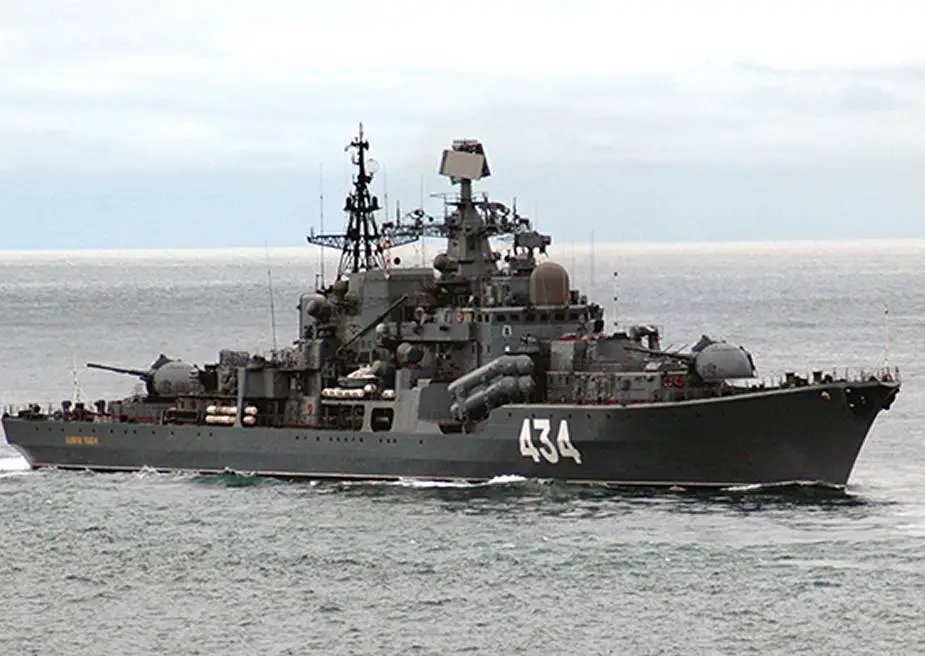Breaking news
Russian Northern fleet continues operating Admiral Ushakov destroyer.
The Russian Defense Ministry has decided to keep the Admiral Ushakov destroyer of project 956 of the Northern fleet operational for several more years. It is to be back from an overhaul in late 2021. The warship encountered technical problems in 2018 and stopped operations. There were plans to scrap it, the Izvestia daily writes.
Follow Navy Recognition on Google News at this link
 Admiral Ushakov destroyer of project 956 (Picture source: Russian MoD)
Admiral Ushakov destroyer of project 956 (Picture source: Russian MoD)
The decision in principle to keep the Admiral Ushakov in the Northern fleet has been made. It is likely to sail out in 2021, Defense Ministry sources said. The overhaul of the only destroyer of the Northern fleet will be done by Zvyozdochka Shipyard. The engines, the main units and mechanisms will be renewed. Electronic systems will be partially replaced. The warship was delivered to the shipyard after major technical problems emerged in the latest sortie.
The Admiral Ushakov operates in the 43rd division of missile warships. It also has the Admiral Kuznetsov aircraft carrier, the Petr Veliky heavy nuclear missile cruiser, the Marshal Ustinov missile cruiser and the Admiral Gorshkov lead frigate of project 22350.
Sarych-class destroyers of project 956 have to fight surface warships. They are armed with a pair of double-barrel 130mm AK-130 guns, Moskit antiship missiles, antiaircraft artillery, 533mm torpedoes and depth bombs. They also carry an antisubmarine Ka-27 helicopter. The destroyers with a displacement of 8000 tons develop a speed of 32 knots and the cruising capacity with a 350-men crew is one month.
The Sovremenny first destroyer of the series became operational in January 1981. In the Cold War, project 956 destroyers had to fight major groups of adversary warships and provide fire support to amphibious assault. In 1980s, they participated in ocean patrols and drills, accompanied foreign aircraft-carrying and attack groups of warships, and constantly monitored NATO activities.
“The return of the Admiral Ushakov is the right decision,” expert Dmitry Boltenkov said. “The Northern fleet does not have enough big warships,” he said.
Project 956 has powerful armaments. However, the boiler-turbine power plant is the weak point. It demands servicing by skilled specialists and regular maintenance. It could not be done in 1990s and many project 956 warships became inoperative. The overhaul can extend the life of the Admiral Ushakov for at least ten years in case of proper operation. It will remain a mighty warship, Boltenkov said.
A total of 17 project 956 destroyers were built instead of a planned major series of 50 warships. Engine problems quickly exposed themselves. Most destroyers were decommissioned before serving the planned period of 20 years. Some were scrapped and others are awaiting utilization.
In the summer of 1998, one of the two boiler-turbine engines of the Admiral Ushakov broke down in a rough sea and the destroyer nearly ran aground. In 2000-2004, the warship underwent medium overhaul at Zvyozdochka Shipyard in Severodvinsk. It then operated in the Northern fleet until 2018 when technical problems emerged.
Besides the Admiral Ushakov, the Russian Navy operates two project 956 warships. The Nastoichivy flagship of the Baltic fleet began an overhaul in 2019 to replace the power plant. The Bystry is operating in the Pacific fleet.
Some project 956 destroyers were sold to China and are still operational. They are being upgraded with new antiship and antiaircraft missiles of the Chinese design, the Izvestia said.
© Copyright 2021 TASS Navy Recognition. All rights reserved. This material may not be published, broadcast, rewritten or redistributed.


























